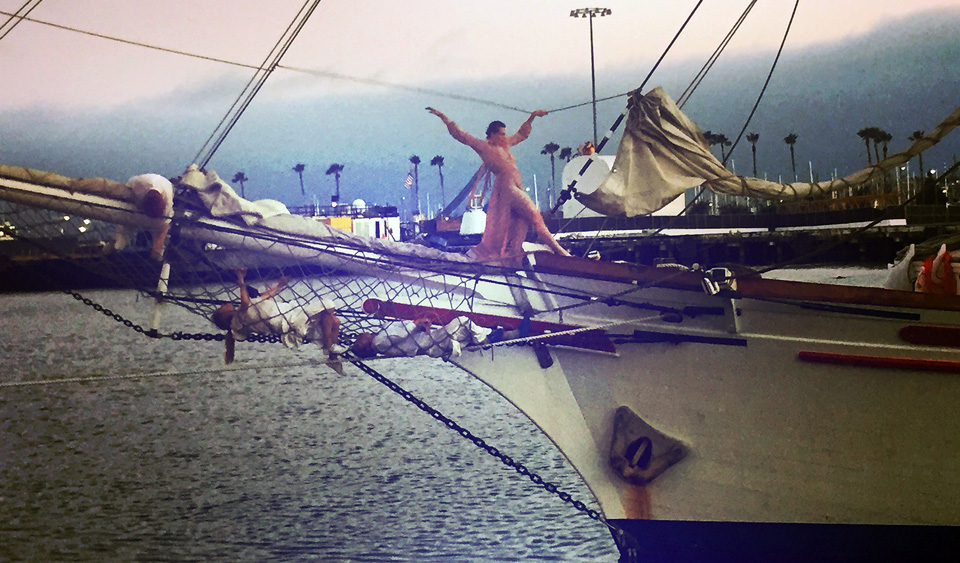
SAN PEDRO, Calif.—Imagine watching Richard Wagner’s opera The Flying Dutchman from your perch on the dock of some Baltic Sea port just as the famous ghost ship pulls into harbor and all the characters come to nautical life before you. What I just witnessed sitting on the wharf of City Dock No. 1, the oldest pier at the Port of Los Angeles in San Pedro—together with neighboring Long Beach the largest port in America, with all those Chinese-manufactured goods coming containerized across the Pacific—offered a faint hint of what might have been, and might yet be.
Beyond the Waterfront was/is a multi-sided collaborative effort combining the resources of the Los Angeles Opera, the locally based Heidi Duckler Dance Theatre, AltaSea at the Port of Los Angeles, Los Angeles Maritime Institute, San Pedro Historic District and the office of Los Angeles City Councilmember Joe Buscaino, and The Boys & Girls Club of L.A. Harbor. It happened one night only, Saturday, June 24, but purportedly it is only the first part, Act I, as it were, of a larger, more developed multi-sensory, multi-disciplinary opus to be presented in a full production next year. What was will be again, bigger and better.
If I mention Wagner it’s not only because of the sea imagery, which appears also in Tristan und Isolde, but because of the 19th-century German composer’s theory of the Gesamtkunstwerk, the work of art that unites all the other arts. We opera lovers appreciate that in any given work we are likely to experience singing, orchestral music, theater, acting, scenography, projections and supertitles, stagecraft, lighting, costuming, dance and whatever other elements the creators want to throw in—jokes, live animals, torches, acrobatics, onstage musicians in dress as village bands or Roman trumpeters, etc.
A large part of the raison d’être of this piece is to showcase the skills of the Heidi Duckler Dance Theatre, which specializes in performances in extraordinary, non-theatrical locations, helping to redefine the relationship between audience and art through fresh spatial re-interpretation. Their lithe, acrobatic dancers (Tess Hewlett, Isaac Huerta, Corina Kinnear, Jillian Meyers and Ryan Walker Page) had never performed on floating ships before, much less tall ships with all their masts and ropes and rigging, subject to unpredictable weather and waves in the water.
For music, Juhi Bansal produced an original Bartokian score for piano, violin, cello and percussion, as well as bird songs and whale calls, that had been pre-recorded and was now amplified. For singers, LA Opera supplied three women (Jamie Chamberlin, Lisa Eden and Melissa Treinkman), who played sirens standing on one of the two tall ships in the production trying to seduce and lure the dancer/sailors doing their thing on the deck and ropes of the facing ship. Both 18th-century brigantines, incidentally, had been built on the L.A. waterfront in 1993 and are in constant use educating young people about maritime arts.
For a text, the women sang excerpts adapted from The Sirens (1840) by poet James Russell Lowell in fetching, searching harmonies sometimes echoing the cry of seagulls. “The sea is lonely and dreary, / The sea is restless, uneasy; you seek quiet. / Our isle is green and breezy, / come rest.”
The immersive arts experience Beyond the Waterfront was announced as honoring American composer Leonard Bernstein, whose centennial is fast approaching in 2018, with reference to his film score for On the Waterfront, the 1954 crime drama directed by Elia Kazan about corrupt unions and a snitching whistleblower informer. The present score, choreography and text, all pretty abstract, had nothing to do with Bernstein other than the shared word “Waterfront” and the similar dockside locale. The Duckler-Bansal work shows none of the social concerns that infuse almost all of Bernstein’s work. Bernstein’s music for the film is spectacular, and sometimes played in concert as a suite, but it reflects a time in his life he wanted to quickly put behind him. He chose to work with the HUAC-friendly witness Kazan by way of redeeming himself before the investigators, for Bernstein had been sharply interrogated as to his political beliefs and barely escaped public censure. It was only by virtue of his fame as a CBS recording artist, his association with the New York Philharmonic, and his growing status as perhaps America’s most accomplished musical ambassador to the world, that he was allowed to quietly “repent” by writing this score.
Beyond the Waterfront showed much creative vitality in collaborating with unlikely partners, turning 258 tons of tall ship into a performance area, and inviting the natural sounds of the port, such as birds, horns, water and wind to contribute further unexpected aural elements. Off in the distance that night someone was setting off fireworks.
The spectacle is very much a work in progress. The relationship between dancers and singers was at best gestural—many arms thrust out in each other’s direction across the span of water between the two ships. There was no narrative development, just the undifferentiated songs of the sirens, and no individual characters. I found the choreography interesting to a point (dancers scampering up and down rope ladders to the fore yard half way up to the top of the mast, or exploring the railings and contours of the ship’s construction) but just generically contemporary and also non-narrative. Some good use was made of buckets lowered into the water, raised to the deck and then poured out to create an unusual effect both visual and sonic. I would say the same of the score: modern but emotionally uninvolving.
It had all the earmarks of being in the experimental stage, with many fertile ideas worth building upon. But at present it is far from the Gesamtkunstwerk that this broad collaboration suggests might be possible. Any expansion of the work needs to address these deficiencies if it is going to hold a future audience’s interest. And please leave Leonard Bernstein out of it.










